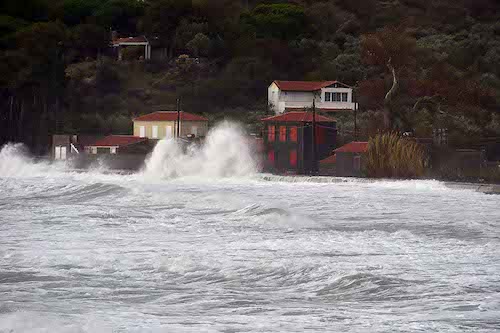November was still presenting lovely summer weather when suddenly Winter mounted a short attack on the island. A storm brought plummeting temperatures, pushing the waves around the island and to unusual heights. I was raised on the North sea and I loved to observe the wild water when the wind was climbing up to 8 Beaufort, especially at the foot of the Pier of IJmuiden. But I have never seen, in either the North sea or the Aegean such high waves — about three meters high, rolling towards the coast, where they roared and they pounded the beaches and against the quay walls: with catastrophic consequences.
The cargo ship Raptor, transporting 6000 tones of salt from Alexandria, Egypt to Istanbul, Turkey disappeared with men and mice into the raging, foaming sea, just some miles off Scala Eresou. The 106 meter long ship, once owned by a dubious North-African company, sailed under the flag of the Comoro islands and had fourteen crew members from India, Syria and Egypt. Only one sailor could be saved.
I wonder if the salt from Egypt is that much cheaper than the salt from Lesvos: what justifies transporting it all the way from the country of the pyramids, whilst Lesvos must be only one day’s travel from Istanbul.
It’s as if the salt pans of Kalloni on Lesvos are only known to the birdwatchers, who specially come to watch migrating birds, like black storks. In October the salt is lifted from the pans and formed into a mighty snow-white mountain, glistening in the sun. It’s difficult to ignore. Then racing trucks carry it over the narrow mountain road to Petra, where the salt boats are waiting in the harbour to deliver it to customers. These salty fields produce some 40,000 tonnes of salt yearly.
The salt pans of Skala Polichnitos are renowned for the large groups of flamingos that forage there on one leg. Here too a bright white mountain stands shining in the sun and is good for some 10,000 tonnes of salt. The white gold of Polichnitos is traded and transported via the port of Scala Polichnitos, alongside the winter trade in shellfish.
Fortunately the island only had material damage when the Winter King went mad. Raging waves ate parts of the quay in Molivos; they created a deep, long fault line in the road of Eftalou. It was as if an earthquake had shaken the road, and in different locations the beaches were lifted across the roads, like in Eresos and Vatera. Temperatures went so low that mountain tops and some mountain villages got buried under a layer of snow — as white as the salt.
Winter Wonderland finally chased away the summer, even though as soon as the storm turned its back to the island, temperatures climbed again to 20 degrees C. We did wait a long time for that rain, but now we have plenty. There has been so much that the trees must be drunk from it all and the salt pans have refilled with water.
Not drunken, but very eager are the grasses that jostle to embrace the sun light, even though those sun rays are sometimes veiled by grey rain clouds. With a little bit of patience you can see the grass grow. Each year it is impressive to see the landscape transform from a dry yellow into a juicy green. Also the mushrooms (that last year didn’t even want to come, through lack of water) are now thankful for all the rain and the high temperatures. Now that the sun is out, I am sure the woods will be pretty busy with mushroom pickers.
Last month was one of the warmest Novembers in Greece. Even whilst cleaning up the traces of the angry winds, all the Christmas stuff is being brought out to decorate the streets. When the crazy winds end and while temperatures keep on braking records, we do not need any road salt and we have a chance to have the warmest Christmas ever. Have a fine December.











